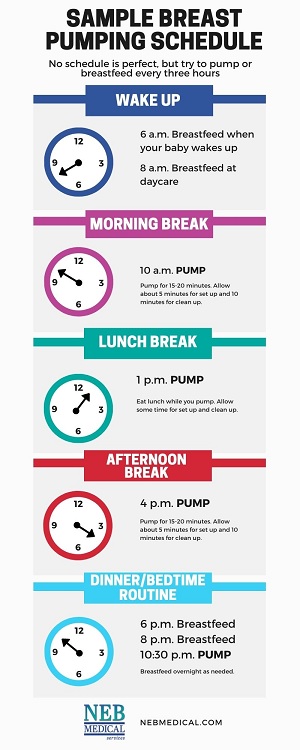So you’ve been breastfeeding your new baby for a few weeks now, and you’ve finally gotten your groove on. But as the date of your maternity leave comes to an end, many new moms start stressing out about how exactly they’re going to get the hang of breast pumping at work.
Don’t worry! With a little planning, you can develop a breast pumping schedule that will provide plenty of milk for your baby and shouldn’t take up too much time out of your work day.
How Much Do I Need to Pump?
If you’ve only breastfed your baby so far, you probably have no idea how many ounces your baby eats. When you start pumping, you may worry that you’re not going to produce enough.
Luckily, moms usually make the exact amount of milk that their babies need to eat. And with a good electric pump, you should be able to produce that same amount of milk in a bottle — which means you’ll likely end up pumping just the amount you need.
However, if you want to calculate approximately how much breast milk you’ll need to pump to feed your baby, you need to start keeping track of feedings a few days before your first day back at work. Count how many times your baby feeds in a 24-hour period. Then take the weight of your baby and multiply it by 2.5, and then divide that number by the number of feeds in a day.
For example, if your baby weighs 10 pounds and does 8 feeds a day, you take 2.5 x 10 lbs./8 feeds, which equals 3.125 ounces per feeding. So if you’re going to be away for three feedings, you should make three bottles with 3.5 ounces in each bottle.
Some babies will eat less from a bottle than he will from the breast, and he’ll make up for it once he’s back on the breast. Other babies will show signs that they want more milk than what the mom provided (especially if they’re going through a growth spurt). So you may want to have a small supply of breast milk on hand in the freezer the first week as you’re figuring things out.
Also, it’s important to encourage your baby’s caregiver to learn how to do paced bottle feeding so the baby doesn’t end up drinking more out of each bottle than necessary.
After a few days of your new working and pumping schedule, you should have a good idea how much your baby eats (and how much you produce) per day. If at some point you start producing less than that amount, you may want to inspect your breast pump to see if you need to replace any parts to improve suction.
Creating a Pumping Schedule
When you go back to work, one of the easiest ways to maintain your milk supply, and make your workday manageable, is to set a regular pumping schedule for yourself. In fact, being upfront with your boss and co-workers about your schedule should help them adjust to your new routine, too.
If you can, try to use your morning and afternoon break times and part of your lunch hour to pump. If you don’t have set break times, talk to your boss about setting aside two 30-minute breaks during the day to pump, which should give you enough time to gather your supplies, pump for 15 to 20 minutes, change your clothes, clean your supplies and get back to work.
When you’re creating your schedule, try to plan to pump every three hours or so, so you’re pumping at the same time your baby would normally be feeding. That way, when you’re back with your baby on the weekends, you’ll be on the same schedule. Plus, it means that your breasts won’t get too engorged by waiting too long.
Here are a few sample pumping schedules:
(Click on infographic to see larger version)

Sample Pumping Schedule 1
7 a.m. Breastfeed before heading to work
9 a.m. Arrive at work
10 a.m. Pump during your morning break
12:30 p.m. Pump during lunch break
3 p.m. Pump during your afternoon break
5 p.m. Leave work
5:30 p.m. Breastfeed your baby at daycare or at home
8 p.m. Bedtime breastfeeding
Breastfeed during the night as needed
Sample Pumping Schedule 2
5:30 a.m. Breastfeed when your baby wakes up
7 a.m. Breastfeed before heading to work
9 a.m. Pump at work
12 p.m. Pump during lunch break
3 p.m. Pump during your afternoon break
5:30 p.m. Breastfeed at daycare or at home
8 p.m. Bedtime breastfeeding
Breastfeed during the night as needed
Sample Pumping Schedule 3
6 a.m. Breastfeed when your baby wakes up
8 a.m. Breastfeed at daycare or when caregiver arrives
9 a.m. Arrive at work
10 a.m. Pump at work
1 p.m. Pump at work
4 p.m. Pump at work
5 p.m. Leave work
6 p.m. Breastfeed at home
8 p.m. Bedtime breastfeeding
10:30 p.m. Pump
Breastfeed during the night as needed
Sample Pumping Schedule 4
5:30 a.m. Pump before your baby wakes up
6 a.m. Breastfeed when your baby wakes up
6:40 a.m. Pump before leaving for work
7 a.m. Leave for work
7:30 a.m. Drop baby off at daycare
8:00 a.m. Arrive at work
10 a.m. Pump during morning break
12:30 p.m. Pump during lunch break
3:30 p.m. Pump during afternoon break
5 p.m. Leave work
5:30 p.m. Breastfeed baby at daycare
6 p.m. Arrive home
7:30 p.m. Bedtime breastfeeding
10 p.m. Pump before bed
Breastfeed during the night as needed
Advantages of Having a Pumping Schedule
Remember, there is no perfect schedule, and every baby and mother (and job situation) is different. The most important thing is to find a schedule that works for you.
Having a set, consistent pumping schedule is key to maintaining your milk supply, because if you start missing sessions, your body may cut back on its milk production. So, if you have to miss a session, try to make it up later in the day.
The other advantage of having a set pumping schedule is that you can block the time off on your calendar so other people won’t try to schedule meetings with you during that time. You can also let your supervisor know that you’ll be busy during those times and have other co-workers cover for you if needed.
Pumping During Your Commute
If you have a long commute to work, you may want to take advantage of that and try to pump while you drive. Just remember to use a hands-free pumping bra so you can keep both of your hands on the wheel!
Want some more tips for how to navigate pumping at work? Check out this blog.


